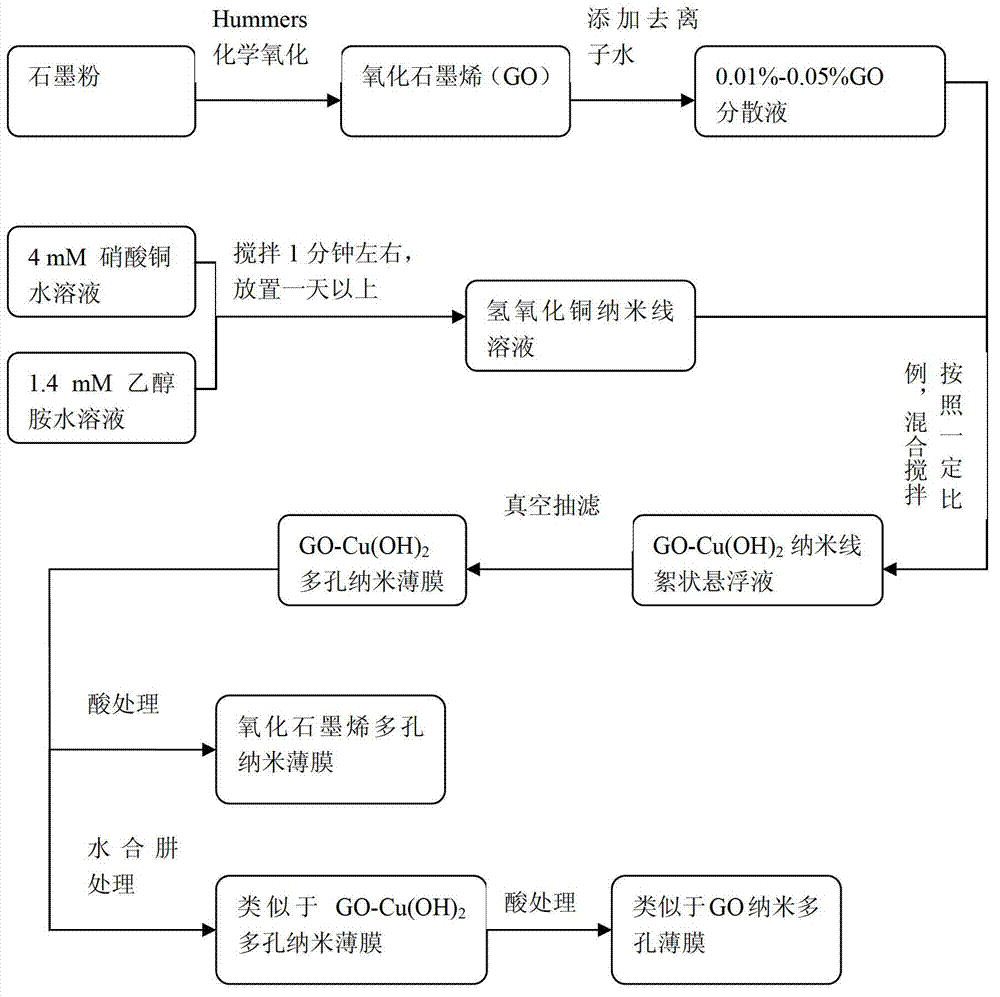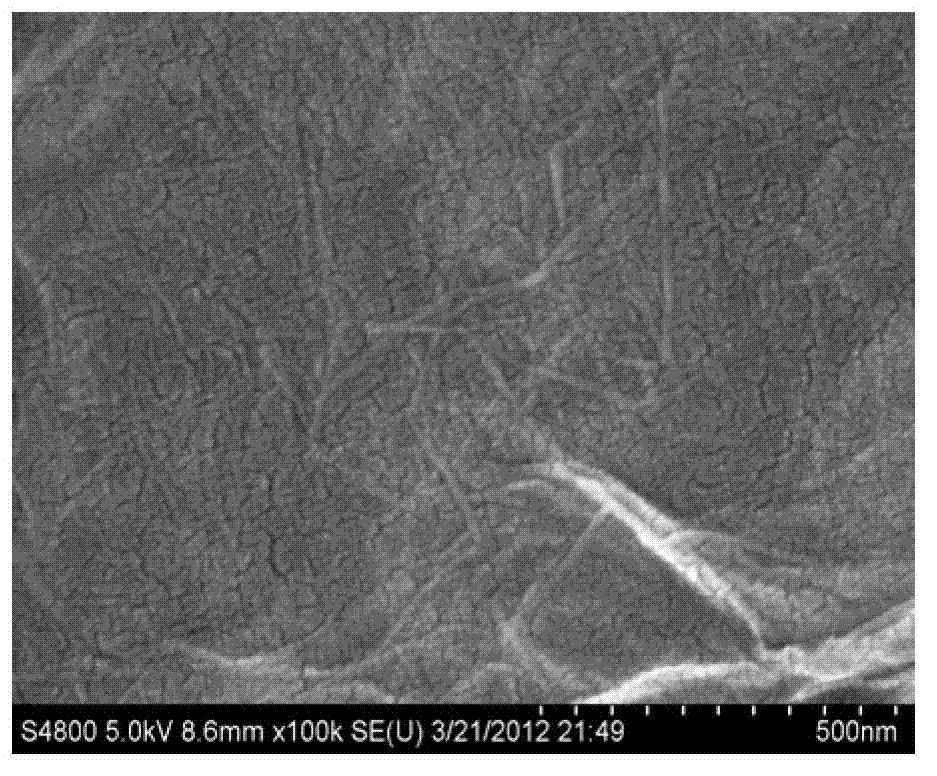Method for preparing graphene oxide base porous film by using metal hydroxide nanowires and graphene oxide, and application of graphene oxide base porous film
A porous film and graphene technology, applied in chemical instruments and methods, copper oxide/copper hydroxide, membrane technology, etc., can solve the problems of low separation efficiency and difficulty of graphene oxide film, achieve superior mechanical properties, good The effect of separation efficiency
- Summary
- Abstract
- Description
- Claims
- Application Information
AI Technical Summary
Problems solved by technology
Method used
Image
Examples
Embodiment 1
[0060] 1) Ultrasonic dispersion of graphene oxide to obtain a graphene oxide dispersion with a mass percentage concentration of 0.005%, for use;
[0061] 2) The same volume of 4 mM copper nitrate aqueous solution and 1.4 mM ethanolamine aqueous solution were mixed evenly under magnetic stirring, and then stood for 1 day to generate Cu(OH) 2 nanowire solution;
[0062] 3) The graphene oxide dispersion with a mass percent concentration of 0.005% and Cu(OH) 2 Nanowire solution, mixed according to the volume ratio of 3:1, mixed for 5 minutes under magnetic stirring to generate GO-Cu(OH) 2 nanowire floc suspension; the GO-Cu(OH) 2 The nanowire flocculent suspension was vacuum-filtered through a polycarbonate porous membrane, and a layer of 0.7 micron thick GO-Cu(OH) was formed on the polycarbonate porous membrane. 2 porous film, the GO-Cu(OH) 2 The pore size of the porous film is 6 nanometers;
[0063] 4) Treat GO-Cu(OH) with 1 mM acid solution 2 A porous film is obtained t...
Embodiment 2
[0065] 1) Ultrasonic dispersion of graphene oxide to obtain a graphene oxide dispersion with a mass percent concentration of 0.1%, for use;
[0066] 2) The same volume of 4 mM copper nitrate aqueous solution and 1.4 mM ethanolamine aqueous solution were mixed evenly under magnetic stirring, and then stood for 1 day to generate Cu(OH) 2 nanowire solution;
[0067] 3) The graphene oxide dispersion liquid with a mass percent concentration of 0.1% and Cu(OH) 2 Nanowire solution, mixed according to the volume ratio of 3:20, mixed for 5 minutes under magnetic stirring to generate GO-Cu(OH) 2 nanowire floc suspension; the GO-Cu(OH) 2 The nanowire floc suspension was vacuum-filtered through a polycarbonate porous membrane to form a layer of 2.5 micron thick GO-Cu(OH) on the polycarbonate porous membrane. 2 porous film, the GO-Cu(OH) 2 The pore size of the porous film is 8 nanometers;
[0068] 4) Treat GO-Cu(OH) with hydrazine hydrate solution at a molar concentration of 1 mM 2...
Embodiment 3
[0070] 1) Ultrasonic dispersion of graphene oxide to obtain a graphene oxide dispersion with a mass percentage concentration of 0.02%, for use;
[0071] 2) The same volume of 4 mM copper nitrate aqueous solution and 1.4 mM ethanolamine aqueous solution were mixed evenly under magnetic stirring, and then stood for 2 days to generate Cu(OH) 2 nanowire solution;
[0072] 3) The graphene oxide dispersion with a mass percent concentration of 0.02% and Cu(OH) 2 Nanowire solution, mixed according to the volume ratio of 3:10, mixed for 30 minutes under magnetic stirring to generate GO-Cu(OH) 2 nanowire floc suspension; the GO-Cu(OH) 2 The nanowire flocculent suspension was vacuum-filtered through a polycarbonate porous membrane, and a layer of GO-Cu(OH) with a thickness of 2 microns was formed on the polycarbonate porous membrane. 2 porous film, the GO-Cu(OH) 2 The porous film has a pore size of 8 nanometers;
[0073]4) Treat GO-Cu(OH) with 1 M acid solution 2 A porous film is...
PUM
| Property | Measurement | Unit |
|---|---|---|
| pore size | aaaaa | aaaaa |
| pore size | aaaaa | aaaaa |
| pore size | aaaaa | aaaaa |
Abstract
Description
Claims
Application Information
 Login to View More
Login to View More - R&D
- Intellectual Property
- Life Sciences
- Materials
- Tech Scout
- Unparalleled Data Quality
- Higher Quality Content
- 60% Fewer Hallucinations
Browse by: Latest US Patents, China's latest patents, Technical Efficacy Thesaurus, Application Domain, Technology Topic, Popular Technical Reports.
© 2025 PatSnap. All rights reserved.Legal|Privacy policy|Modern Slavery Act Transparency Statement|Sitemap|About US| Contact US: help@patsnap.com



